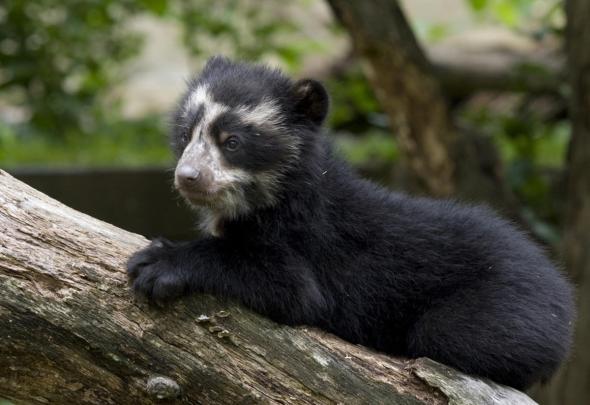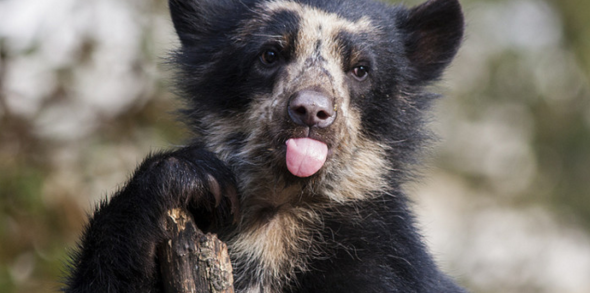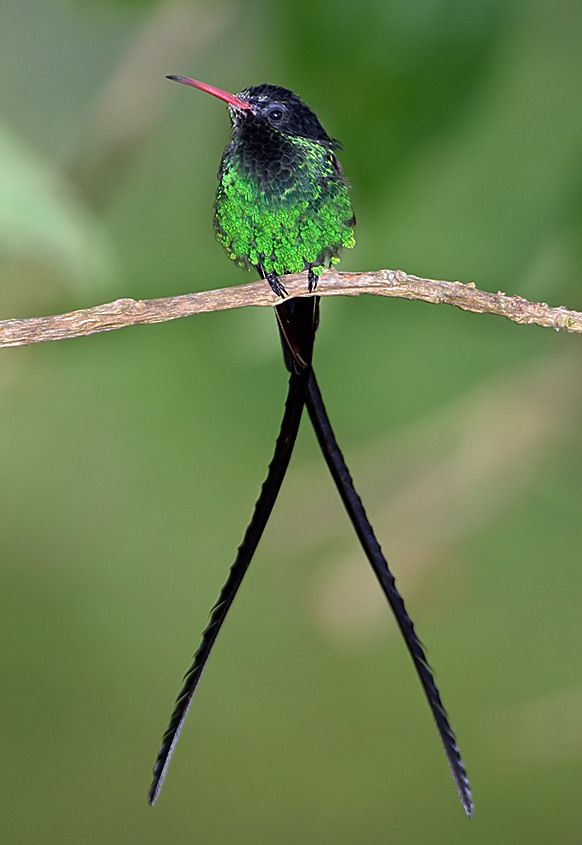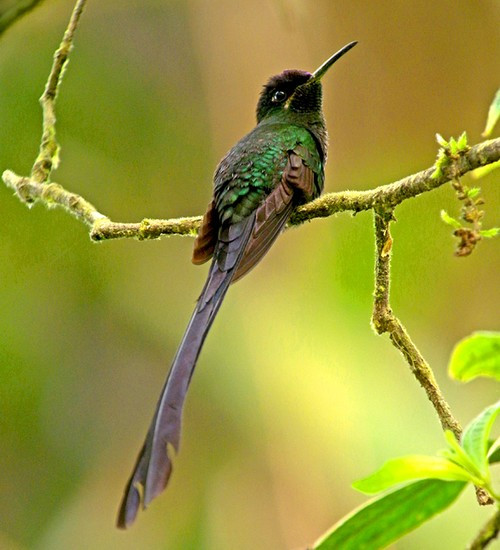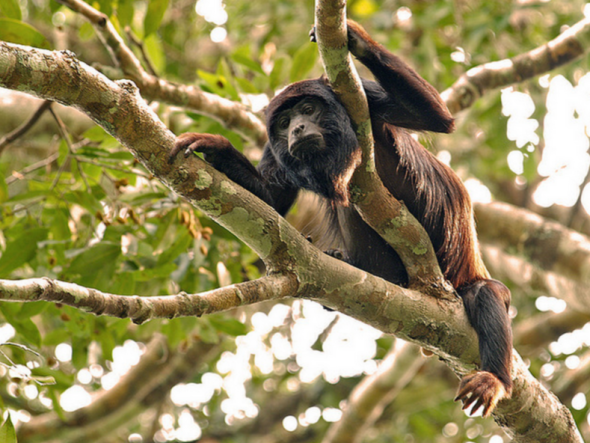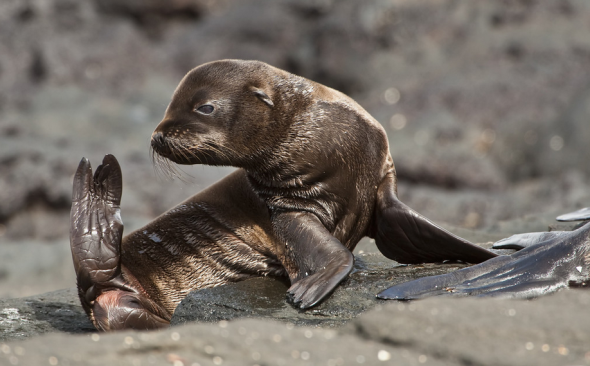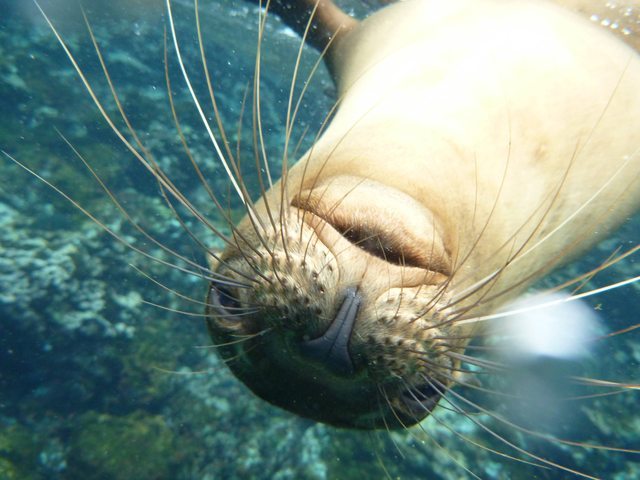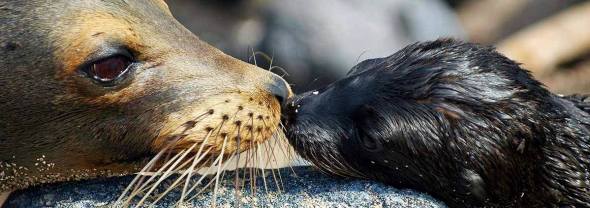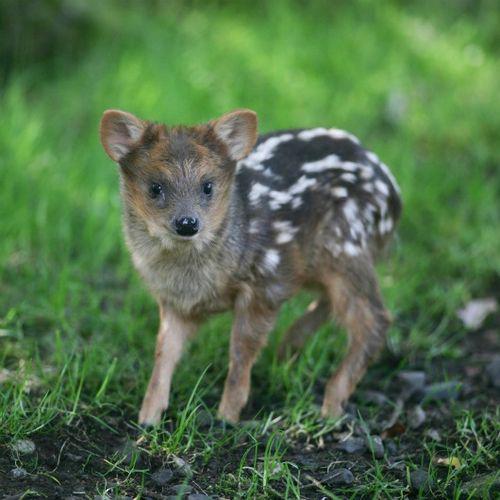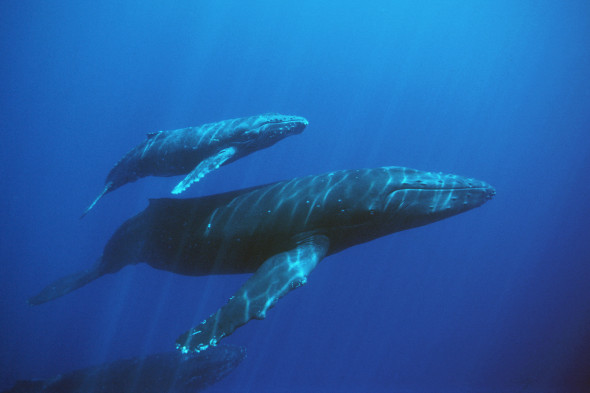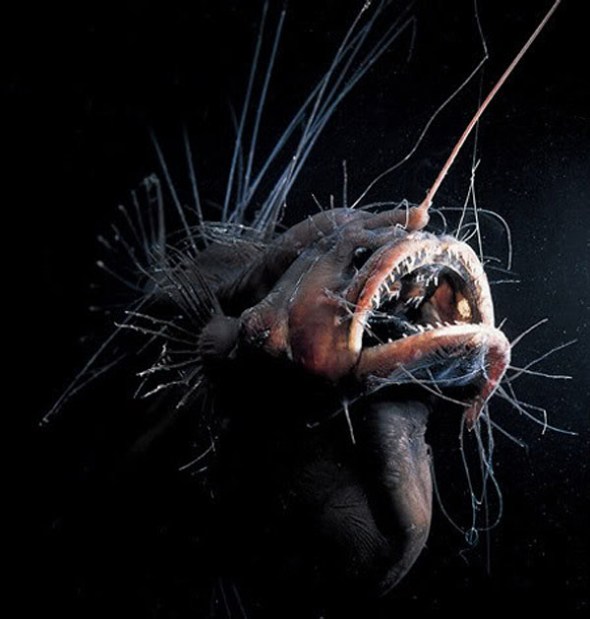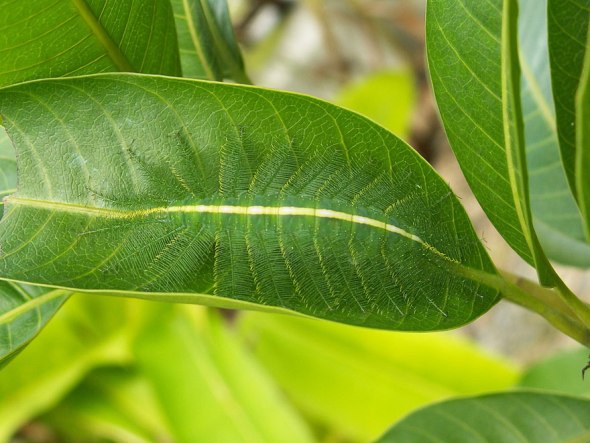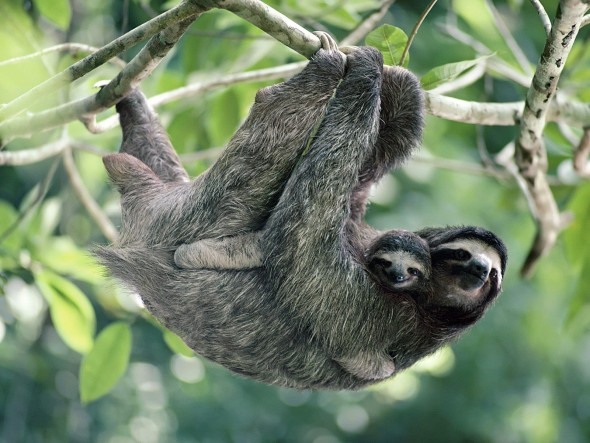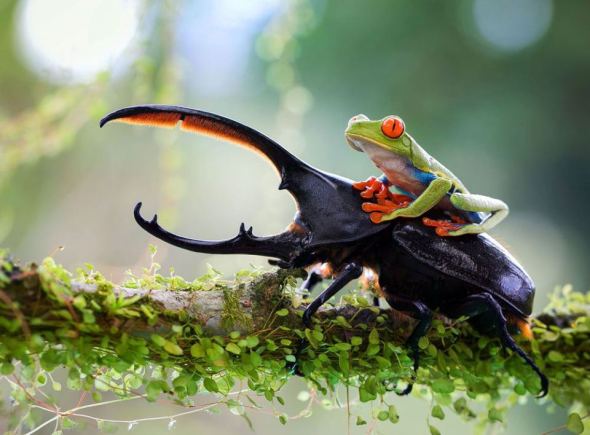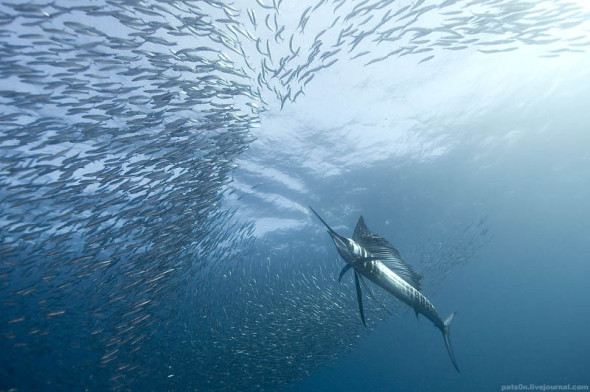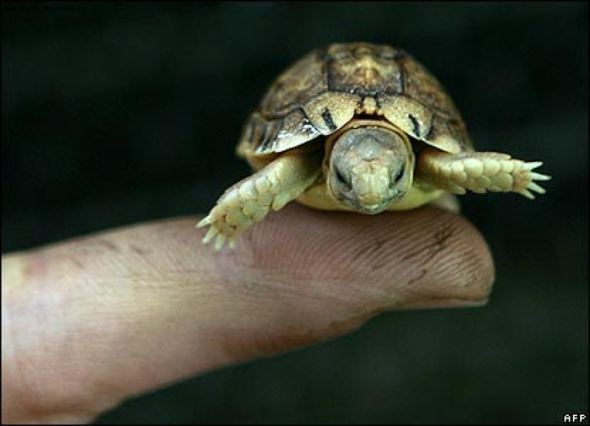Endangered Species Monday: Tremarctos ornatus
Endangered Species Monday: Tremarctos ornatus
This January’s (2016) Endangered Species Watch Post is dedicated to the Tremarctos ornatus, commonly known as the Andean Bear or Spectacled Bear. The species was identified by Dr Jean Léopold Nicolas Frédéric Cuvier back in 1825. Dr Jean Léopold Nicolas Frédéric Cuvier lived from (23 August 1769 – 13 May 1832), known as Georges Cuvier, was a French naturalist and zoologist, sometimes referred to as the “Father of paleontology”. Cuvier was a major figure in natural sciences research in the early 19th century and was instrumental in establishing the fields of comparative anatomy and paleontology through his work in comparing living animals with fossils.
From 1982 to 1996 the Andean Bear has been listed as (vulnerable), of which its main threats are habitat loss and major poaching for the animal parts trade. Within the past thirty years populations have declined by a staggering 30% which qualifies the bear as being listed as (vulnerable). Habitat loss continues at a rate of 2-4% per year, which as yet doesn’t look set to decline. Furthermore identified threats do not look set to decrease anytime soon which could see this stunning animal pushed into extinction very soon.
Poaching is one of the main problems that can be controlled if (anti poaching enforcement) is increased within the bears habitat, unfortunately this is easier said than done. Furthermore, continued habitat destruction and illegal logging will see forest tracks opened up within the bears natural habitat, thus allowing poachers to walk freely into the bears home environment, thus seeing poaching occur. Anti poaching enforcement is a must, and needs to be taken seriously by all international (non-governmental organisations) that are working to sustain this animals welfare, and habitat.
Endemic to Bolivia, Colombia; Ecuador; Peru, and Venezuela, populations of the Andean Bear are now known to be decreasing rapidly, however populations are not reported to be (fragmented). Back in 1998 it was estimated by Dr Peyton that there was a mere 20,000 Andean Bears remaining. A 2003 survey, however estimated that there was in between 5,000 to 30,000 Andean Bears remaining. Andean Bears are now commonly located within the eastern Andes of which bear populations exist from the snowline down to 300 m asl in the Tapo-Caparo National Park in Venezuela. Andean Bears can also be located at high altitudes in Ecuador, Peru, Bolivia, and Columbia.
Andean Bears are “omnivores”, meaning that they feed exclusively on plant matter, fruits, bark and occasionally will consume meat of other animals, the bears preferred diet though is reported to be species of flora from the Bromeliaceae and Arecaceae. Activity patterns range from strictly diurnal for wild bears in Bolivia to mixed diurnal and nocturnal for reintroduced bears in Ecuador.
“EXTINCTION BY 2030 IS POSSIBLE”
As food is available year-round in all parts of their range, Andean bears do not hibernate. Based on the first few individuals of this species to be monitored using ground telemetry in Bolivia and Ecuador, home ranges overlap to a high degree and minimum home range sizes vary from 10 to 160 km² (although these are underestimates, as the bears were regularly out of range of radiotelemetry in both studies).
The Andean Bear stands at around 5ft to 6ft tall, and weighs in at around 220, 330lbs. The markings on the Andean bear’s face, neck and chest are exactly like human finger prints (unique to each and every individual Andean Bear). Andean bears are very timid and shy and prefer to live in isolated cloud forests, of which they are “mainly nocturnal” however will at times feed, live and socialize in daylight (although this is considered rare). Favorite foods are cacti, berries and of course honey.
Andean bears are quite typically solitary animals, and will only be seen in pairs during mating season. Females normally give birth to (1-2 cubs), cubs are normally mobile after one month, however will remain with their “mother” for up to eight months, mothers will often be seen with little cub hitching a ride on the back on the mothers back. Population studies state today that there may be no fewer than 3,000 Andean bears in the wild., which if true could soon see the species nearing extinction by 2030.
ANDEAN BEAR THREATS
Habitat loss and fragmentation, poaching, and the lack of knowledge about the distribution and status of the Andean Bear are the principal threats to this species. Much of the range of the Andean Bear has been fragmented by human activities, largely resulting from the expansion of the agricultural frontier. In some areas, mining, road development and oil exploitation are becoming a greater menace to Andean Bear populations as well as to local communities, due to land expropriation, loss of habitat connectivity, and water and soil contamination.
Many Andean Bear populations are isolated in small to medium-sized patches of intact habitat, particularly in the northern part of the range. The situation tends to improve towards the southern range, with some large patches of wilderness still remaining. Nevertheless, human population growth and national development plans throughout the Tropical Andes continue to be an important cause of habitat fragmentation and to threaten the connectivity among remaining wilderness patches.
Poaching is a serious threat throughout the Andean Bear range. Bears are often killed after damaging crops, particularly maize, or after purportedly killing livestock. Also, Andean Bear products are used for medicinal or ritual purposes and at some localities Andean Bear meat is highly prized. Live bears are also sometimes captured and sold.
Human induced mortality endangers the viability of small remnant populations. Lack of knowledge about the distribution and status is a problem throughout the region. In many areas, information about the status of Andean bears is outdated or, particularly in the southern portion of the range, simply non-existent. The absence of knowledge makes it difficult to develop realistic management plans for the conservation of this species, or to monitor changes in its distribution (reflective of changes in population status).
It is without a doubt the Andean Bear is facing “imminent extinction”, and from studies that are being conducted by various organisations including the International Animal Rescue Foundation Brazil, its very likely this animal is going to be pushed into extinction very soon.
Thank you for reasding the first part of this years (2016) Endangered Species Watch Post, and please feel free to scroll through 2014-2015’s posts below via the automatic scroll new feed bar.
Dr Jose C. Depre PhD. MEnvSc. BSc(Hons) Botany, PhD(NeuroSci) D.V.M. Environmental & Human Science
Chief Environmental Officer and Director
Donate today and help us continue our worldwide anti-wildlife trade enforcement operation continuing. Please click the DONATE button below.
DONATE BUTTON
Endangered Species Monday: Hylonympha macrocerca
Endangered Species Monday: Hylonympha macrocerca
This Monday’s Endangered Species Post (ESP) watch I take a rare glimpse into the life of Hylonympha macrocerca, commonly known as the Scissor Tailed Hummingbird. Identified in 1873 by Dr John Gould FRS September 1804 – 3 February 1881) whom was an English ornithologist and bird artist. He published a number of monographs on birds, illustrated by plates that he produced with the assistance of his wife, Elizabeth Gould, and several other artists including Edward Lear, Henry Constantine Richter, Joseph Wolf and William Matthew Hart. He has been considered the father of bird study in Australia and the Gould League in Australia is named after him. His identification of the birds now nicknamed “Darwin’s finches” played a role in the inception of Darwin’s theory of evolution by natural selection. (Image: Scissor Tailed Hummingbird)
Listed as (endangered) this remarkable specimen was listed as threatened back in 1988. Since this time little conservation efforts have been seen to improve the species overall status within the wild of which extinction is incredibly likely. From 1994 to 1996 the species was listed as critically endangered. From the start of the Millennium conservation efforts did improve the wild status of the hummingbird to (vulnerable), unfortunately from 2008 to date the species has been re-listed as endangered again. From my own evaluations of the birds current threats and shrinking habitat, extinction will occur within the next five to ten years, unless conservation efforts improve, funding increases and dangers disperse soon.
Endemic to Venezuela and Bolivia evidence has shown that overall population sizes are decreasing very rapidly. The population trend when last evaluated back in 2012, showed around 10,000 to 19,900 ‘individuals’ within the wild. This equates to exactly 6,000 to 13,000 ‘mature individuals’ remaining, which is rounded to 6,000 to 15,000 ‘birds in total’. The Scissor Tailed Hummingbird specie inhabits lower and upper montane humid forest, where it has been recorded at 800-1,200 m on Cerro Humo, and 530-920 m further east.
In primary forest, the specie feeds mainly at bromeliad flowers and on their insect inhabitants, whereas in secondary forest, feeding is associated with the shrubs Heliconia aurea and Costus sp. Although it is regularly seen feeding on Heliconia in open areas it may nevertheless be dependent on the availability of pristine forest nearby. It also hawks insects from exposed perches. There may be seasonal movements.
Major Threats
Listed on Cites Appendix II (Convention on International Trade of Endangered Species wild flora and fauna), increases in cash-crop agriculture, especially the cultivation of “ocumo blanco” (Xanthosoma sagittifolium) and “ocumo chino” (Colocasia esculenta), since the mid- to late 1980s have resulted in some uncontrolled burning and forest degradation. Cerros Humo and Patao have been worst affected, with the east of the peninsula fairly undisturbed.
Since it is an understorey inhabitant, removal of understorey vegetation for coffee and cacao cultivation is likely to lead to reduced population density. It is considered nationally Endangered in Venezuela, and has been recognized as a “high priority” species, amongst the top dozen priorities for bird conservation in Venezuela.
Image: Scissor Tailed Hummingbird.
Occasionally the species is misidentified as the Red-billed streamertail which is also commonly known as the scissor-tail or scissors tail hummingbird. However its fairly easy to distinguish between the two when viewing online or within books. This particular species (in question) is not native to Jamaica, and one can quite easily differentiate between the two. The Scissor Tailed Hummingbird has obviously acquired its name due to its unique scissor tailed rump feathers, whereas the Jamaican Red-billed streamertail doesn’t host the same features but more as explained - streamer like rump feathers.
Sadly as explained due to increasing threats we will lose this bird unless conservation efforts improve dramatically and dangers subside. However this is unlikely to occur. The Scissor Tailed Hummingbird will be yet another species of bird added soon to the extinction list of amazing birds, that we humans have destroyed. The video below depicts a female Scissor Tailed Hummingbird within the Venezuela wild.
Thank you for reading.
Dr Jose C. Depre.
Environmental and Botanical Scientist.
Endangered Species Monday: Alouatta belzebul.
Endangered Species Monday: Alouatta belzebul
This Monday’s endangered species article from the (Endangered Species Watch Post) focuses on the Red Handed Howler Monkey of which is listing near to endangerment. (Image Red Handed Howler Monkey)
Generically identified as Alouatta belzebul back in 1766 by Professor Carl von Linnaeus (1707 – 10 January 1778), also known after his ennoblement as Carl von Linné was a Swedish botanist, physician, and zoologist, who laid the foundations for the modern biological naming scheme of binomial nomenclature.
Listed as vulnerable the species is endemic to Brazil (Alagoas, Maranhão, Pará, Paraíba, Pernambuco, Rio Grande do Norte, Sergipe and Tocantins). Populations are currently on the decline of which its very likely the species will be re-categorized as endangered within the next five years, if not sooner.
A. belzebul is said to be extremely common in some areas such as Marajó however is noted as rare within the Atlantic Forest portion of the range known as; Rio Grande do Norte, Alagoas, Paraíba and Pernambuco. Last survey census’s reported the species to be inhabiting at least ten isolated locations of which two hundred individuals remain in each plot.
International Animal Rescue Foundation Brazil have for the past three years been conducting surveys within the area will be submitted to the (IUCN). Furthermore the Environmental Protection Unit now re-based in Londrina are working with local communities, hunters and farmers within the A. belzebul range to preserve commonly known species of monkey, birds, amphibians and flora within the region.
IARFB are also currently conducting investigations to locate where sugar cane is being exported too and used within from the A. belzebul’s region. Its believed that America, Mexico, South America, and Europe are purchasing large sugarcane exports from the region. Tesco, J.S Sainsbury’s, Cooperative Food Group, Asda, Walmart, Woolworths and Spar have all been noted on suppliers exports from the regions. Aldi, Lidl, Quick-Save, Budgens have been ruled out. We are least impressed though with J.S Sainsbury’s name written on export documents of sugar cane from the region.
Within the ten isolated locations six populations are known to reside in Paraiba, two in Rio Grande de Norte, one in Pernambuco, and one in Alagoas. The largest population in the Atlantic Forest is in Pacatuba in Paraiba with about 80 animals. There have been five registered local extirpations from forest fragments in the last 50 years.
Little known conservation actions are under way within their endemic region and as explained populations are decreasing and nearing endangerment. A. belzebul is listed within the family of Atelidae which is one of the very first five of new recognized ‘new world monkeys’. Its quite likely that new sub-species of the Red Handed Howler Monkey may be located as well as newer species of ‘new world monkeys’ too within the coming years. Only five years ago did scientists locate over 100,000 new species within the Yasuni National Park, Ecuador so in reality anything is possible.
The Atelidae family host howler, spider, woolly and woolly spider monkeys (the latter being the largest of the New World monkeys). They are found throughout the forested regions of Central and South America, from Mexico to northern Argentina.
When the species is not foraging on the ground floor they can normally be found resting in the canopies of trees at a height of some sixty feet. Social groups normally consist of seven to twenty members that will host mature males, females juveniles and infants. Males normally take lead of the pack or (troop).
These large and slow-moving monkeys are the only folivores of the New World monkeys. Howlers eat mainly top canopy leaves, together with fruit, buds, flowers, and nuts. They need to be careful not to eat too many leaves of certain species in one sitting, as some contain toxins that can poison them. Howler monkeys are also known to occasionally raid birds’ nests and chicken coops and consume the eggs.
Image: Adult Red Handed Howler Monkey.
Howlers are the only New World primates which regularly include mature leaves in their diet, although softer, less fibrous, young leaves are preferred when they are available. Their folivory and ability to eat mature leaves is undoubtedly one of the keys to their wide distribution and the wide variety of vegetation types they inhabit.
Mature fruit is the other important food item, especially wild figs (Ficus) in many regions, but they also eat leaf petioles, buds, flowers (sometimes seasonally very important), seeds, moss, stems and twigs, and termitaria. The diet of two A. belzebul groups in the Caxiuanã National Forest was studied by Souza et al. (2002). They were largely folivorous but would switch to fruits whenever available, especially during the wet season.
Size:
Adult male weight 7.27 kg (n=27),
Adult female weight 5.52 kg (n=26)
Adult male weight 6.5-8.0 kg (mean 7.3 kg, n=27),
Adult female weight 4.85-6.2 kg (mean 5.5 kg, n=26) .
Threats
Listed on Cites Appendix II there are few threats associated with the species. Nevertheless they still remain and if left unchecked can rapidly increase placing the new world monkey in danger of extinction.
In the Amazon, the species is widespread, although they are hunted. The Amazon populations have suffered severely from forest loss throughout their range in southern Pará over the last decade. In the Atlantic Forest population, the major threat is the fragility of the remaining small forest patches to stochastic and demographic affects (habitat loss and fragmentation has been mainly due to sugar-cane plantations).
Please share and make aware the Red Handed Howler Monkey’s plight. Tip: Check sugar products from local shops and hypermarkets to ensure your not aiding the destruction of their natural habitat via your sugar purchase. Check your local candy and other shopping supplies. If necessary contact companies politely asking where they are obtaining the sugar products from. Never give up.
Thank you for reading.
Dr Jose C. Depre.
Environmental and Botanical Scientist.
Chief Executive Officer
Endangered Species Friday - Arctocephalus galapagoensis
Endangered Species Friday - Arctocephalus galapagoensis
This Fridays endangered species article we take a brief look into the life of the Galapagos Fur Seal, scientifically identified as Arctocephalus galapagoensis, and identified back in 1904 by marine biologist Dr Heller. Listed as endangered the species is endemic to Ecuador, and the Pacific South East. Pictured above is one of many declining colonies of the Galapagos Fur Seal Pups (credited to Stephanie Brand) from Arizona, United States.
Back in 1982 the species was officially declared “out of danger” however from 2010 reports soon came flocking in that the Galapagos Fur Seal was again listing back into its old threatened status. From 1996 evaluations of the species saw A. galapagoensis relisted as (vulnerable).
Further opinionated evaluations by marine biologists Baillie and Groombridge confirmed the species was sadly nearing the realms of endangerment (1996). Census’s of A. galapagoensis (2010) have unfortunately relisted the species as now (endangered). A final evaluation of species populations now confirms populations are declining, very rapidly.
Back in 1978 environmentalists conducted a marine census of the species that placed the population size at some 30,000 to 40,000 individuals. El Niño which is the warm phase of the El Niño Southern Oscillation (commonly called ENSO) and is associated with a band of warm ocean water that develops in the central and east-central equatorial Pacific (between approximately the International Date Line and 120°W), including off the Pacific coast of South America, has been blamed for high mortality rates of seal pups.
Image: Galapagos Fur Seal
Population sizes have been said to be (fluctuating) since the last in-depth populastion report on the species back in the mid to late nineteen seventies. Recovery since this time is currently unknown, however reports from 2010 can be viewed here that do provide further although little information on recovery at least. Surveys undertaken since the last 2010 report now place the number of A. galapagoensis at a depressing 10,000 to 15,000 individuals. That’s quite a significantly large decline since the species last census count, and on discovery of which population sizes were over 70,000-90,000 individuals 1904-1908-(census).
Galápagos Fur Seals live in large colonies on the rocky shores. These colonies are then divided into territories by the female seals during breeding season, which is mid-August to mid-November. Every mother seal claims a territory for herself and breeds her pup there. Galápagos Fur Seals have the lowest reproductive rate reported in seals, and it takes an unusually long time to raise seal pups to independence.
Females bear only one pup at a time, and she remains with her newborn for a week before leaving to feed. She then periodically returns to the pup and stays to suckle it for a few days before leaving on another hunting trip. Females recognize their own pups by smell and sound, and pups also learn to identify their mothers by the females’ “Pup Attraction Calls”.
Mother-pup recognition is crucial because females exclusively nurse their own pups, often violently rejecting strange pups that approach. Orphaned seal pups usually try to sneak up on sleeping or calling females to suckle, but stealing milk is not enough to sustain the pups, and they usually die within a month.
The Galápagos Fur Seal feeds primarily on fish and cephalopods. They feed relatively close to shore and near the surface, but have been seen at depths of 169 m (554 ft). They primarily feed at night because their prey is much easier to catch then. During normal years, food is relatively plentiful. However, during an El Niño year, there can be fierce competition for food, and many young pups die during these years. The adult seals feed themselves before their young and during particularly rough El Niño years, most of the young seal populations will die.
The Galápagos Fur Seal has virtually no constant predators. Occasionally, sharks and orcas have been seen feeding on the seals, but this is very rare. Sharks and orcas are the main predator of most other seal species, but their migration paths do not usually pass the Galápagos.
Image: Galapagos Fur Seal and Cub
Threats
Similar to all southern fur seals there was a severe population decline as a result of 19th century exploitation by sealers and whalers. The species was near extinction early in the 20th century and has since recovered (although as explained species populations are declining and the Galapagos Fur Seal species are listed as endangered).
El Niño events dramatically elevate mortality rates of all age classes and cause population declines; this is due to the dramatic declines in productivity around the Archipelago during these events. Tourism in the Galápagos, which is an Ecuadorian National Park, is heavy but regulated, and fur seals are protected.
Episodes of entanglement in local net fisheries have been reported and are thought to be increasing over the last years. Feral dogs on Isabela Island which killed fur seals of all ages have been exterminated. This problem could erupt again if other feral dogs find their way to colony sites.
The most serious threat at present is transmission of diseases from dogs to pinnipeds. Like all fur seals, Galápagos Fur Seals are vulnerable to oil spills because of their dependence on their thick pelage for thermoregulation. Although there is limited large vessel traffic in the Galápagos Archipelago, numerous small and medium sized vessels operate in the area that could release moderate quantities of oils, fuels, and lubricants if involved in a marine accident.
Galápagos Fur Seals have experienced declines from El Niño-caused ocean warming and associated reduced marine productivity (Trillmich and Dellinger 1991) estimated of up to 80%, but the exact extent of population reduction is not clear. Therefore, although the effects of global climate change on this species and its habitat are uncertain at this time, it is possible that any change related disruption of present day ocean currents, levels of marine productivity, or increased air temperatures at haul out sites would adversely affect this species.
Despite their population size, the Galápagos Fur Seal population will always be vulnerable to a variety of threats because of the species’ restricted distribution to a relatively small Archipelago of islands.
International Animal Rescue Foundation Brazil worked with these stunning animals for approximately a year and a half. The South American organisation has sadly stated that the species may soon be extinct within the next decade. Despite “any” protection measures that we or other throw at the species we have non-human and non-animal natural events that could wipe the entire species out in a single El Nino season.
Thank you for reading.
Chief Executive Officer/Chief Environmental Officer
Dr Jose C. Depre.
International Animal Rescue Foundation Africa - Asia.
Chief Environmental Officer South America and Europe. (Head Registrar).
Dr J. Williamson EnVstu. PhD, Ba.
International Animal Rescue Foundation Europa - South America - United States
Have you spotted a typo or error? Please email us above and we’ll work to rectify the problem as soon as possible.
Animal Planet - Mother Natures Finest
Mother Nature hides many secrets that we as humans are still fully unaware of. Below is a quick run down of Mother Natures finest specimens of animals that International Animal Rescue Foundation has picked for your information.
In at number one is the smallest deer in the world.
Pudus Deer;
Endangered
The pudús are the world’s smallest deer, with the southern pudú being slightly larger than the northern pudú. It has a stocky frame supported by four short and slender legs. It is 32 to 44 cm (13 to 17 in) high at the shoulder and up to 85 cm (33 in) in length. Pudús normally weigh up to 12 kg (26 lb), but the highest recorded weight of a pudú is 13.4 kg (30 lb). Pudús have small, black eyes, black noses, and rounded ears with lengths of 7.5 to 8 cm (3.0 to 3.1 in). Sexual dimorphism in the species includes an absence of antlers in females. Males have short, spiked antlers that are not forked, as seen in most species of deer. The antlers, which are shed annually, can extend from 6.5 to 7.5 cm (2.6 to 3.0 in) in length and protrude from between the ears. Also on the head are large preorbital glands. Pudús have small hooves, dewclaws, and short tails about 4.0 to 4.5 cm (1.6 to 1.8 in) in length when measured without hair. Coat coloration varies with season, gender, and individual genes. The fur is long and stiff, typically pressed close to the body, with a reddish-brown to dark-brown hue. The neck and shoulders of an aged pudú turn a dark gray-brown in the winter.
In at number two is the loudest animal on the planet the Blue Whale;
Endangered
The blue whale is the loudest animal on the face of the earth. However not far off from the this mega beast is the second loudest animal on the planet being that the Howler Monkey.
The call of the blue whale reaches levels up to 188 decibels. This extraordinarily loud whistle can be heard for hundreds of miles underwater. Theoretical calculations by Roger Payne and Douglas Webb (from the 1970’s) predicted that the loudest whale sounds might be transmitted across an entire ocean. The blue whale is much louder than a jet, which reaches only 140 decibels! Human shouting is 70 decibels; sounds over 120 decibels are painful to human ears. The second-loudest animal on Earth is the howler monkey (Alouatta) from the jungles of Central and South America.
In at number three is the Honduran White Bat;
The only white bat on the face of the planet of which is just that “white” and not albino. Whats so special about the Honduran White Bat though other than its white? Well its the only bat that doesn’t actually live within caves, more rather under heliconia leaves.
Near threatened
The Honduran white bat cuts the side veins extending out from the midrib of the large leave of the Heliconia plant causing them to fold down to form a ‘tent’. They cling to the roof of this tent in small colonies of up to half a dozen individuals, consisting of one male and a harem of females. The tent protects them from rain and predators. Most tent-making bats take flight at even slight disturbances, but researchers in Costa Rica have reported that Honduran white bats take flight only when the main stem of their tent is disturbed, possibly because they are well camouflaged. Although their tents are typically low to the ground (about six feet), sunlight filters through the leaf which gives their white fur a greenish cast. This almost completely conceals them if they remain still. It has been suggested a colony may have a number of tents scattered within the forest. It is one of 15 species of Latin American bats that roost in tents. In the Old World, 3 species of bat from India and Southeast Asia are known to roost in tents.
In at number four is the angriest looking animal on the planet, the Angler Fish;
IUCN Red List - Unknown
In the darkest depths of the ocean where the water is freezing cold, the pressure is enormous and food is scarce lives the angry-looking deep sea anglerfish. This fascinating fish is not only an incredible example of how organisms manage to survive in the most inhospitable environments, it has one of the most bizarre ways of reproducing in the animal kingdom. The deep sea anglerfish is one of the deep ocean’s most fascinating residents. Living at the extreme depths between 1.5 and 2.5 km, their most peculiar appearance is a modified fin that acts as a lure, hanging above their huge mouths containing needle-like teeth. The tip of this “fishing rod” on top of their head is bioluminescent (glowing in the dark) because of bacteria living inside it and attracts prey in a similar way like moths to a lightbulb. By wiggling the glowing outgrowth, it lures prey close enough to devour them whole. Because of thin, soft bones and jelly-like skin, these scary looking fish can expand their jaws and stomach to such an extent that they are even able to actually swallow prey up to twice their own size. In the deep sea where food is very scarce, being able to eat large quantities at once is a great adaptation. Now that’s pretty awesome but weird yet wonderful too..
In an number five is the worlds most camouflaged animal the Common Baron Caterpillar;
IUCN Red List - Unknown
Just take a closer look at the image below. Do you see anything besides a leaf? If you look closer you can catch a glimpse of a tiny little fellow called, the common baron caterpillar. Feeding mostly on mango and cashew nut trees during its larvae stage; they remarkably camouflage themselves and seemingly disappear into foliage. We are sympathizing for the birds which don’t get a chance to swoop on them. However, as soon as they evolve from larvae to butterfly stage, they lose their camouflaging ability. The common baron caterpillars are native to India and Southeast Asia. The males are brown with slight tinges of olive, whereas the females are of paler shades. Their camouflage of course boosts their chances survival. When the common baron caterpillar goes through all stages of life they eventually metamorphose into a butterfly called the common Baron, which is a medium-sized the ‘nymphalid butterfly’. Now this is one species of animal the armed forces need to take a leaf out of “its” book. And no the photograph is not edited.
In at number six the slowest (mammal) on the planet, the Three Toed Sloth;
Near threatened
The three-toed sloth is the slowest mammal on Earth, due to its lack of muscle tissue.It is so sedentary that algae grows on its furry coat. All sloths are built for life in the treetops. The three-toed sloths are tree-living mammals from South and Central America. They are the only members of the genus Bradypus and the family Bradypodidae. The four living species of three-toed sloths are the brown-throated sloth, the maned sloth, the pale-throated sloth, and the pygmy three-toed sloth.. And just to give you a brief glimpse into the sheer speed of the three toed sloth - they travel at a distance of 0.15 kilometers per hour.
In at number seven is the worlds strongest insect, stand aside Mr leaf cutting ant as your title has been beaten. Meet the Rhinoceros Beetle;
IUCN Red List - Unknown
Rhinoceros Beetles can lift 850 times their own weight. To put this into perspective, if a human had the strength of the rhinoceros beetle, it would be able to lift a 65 ton object. If the mighty elephant had equal strength to the rhinoceros beetle it would be able to carry 850 elephants on its back.
The Hercules beetle (Dynastes hercules) is the most famous and the largest of the rhinoceros beetles. It is native to the rainforests of Central America, South America, and the Lesser Antilles. The beetle has also been observed as far north as Southern Veracruz in Mexico. Their title is well deserved, with some able to lift more than 850 times (up to 8 kg lifted) their own weight and some males, rarely, reaching 17 cm (6.75 inches) in length. It is the largest of the six species in the Dynastes genus, and one of the largest beetles known, being exceeded in length by only two other beetles in the family Cerambycidae, Macrodontia cervicornis (specimens of 17–17.5 cm are known) and Titanus giganteus (also up to 17–17.5 cm; several 18+ cm specimens are reputed/alleged to exist). However, if the horns are excluded, both M. cervicornis and D. hercules drop considerably farther down in the size rankings, leaving T. giganteus on top. One reason for this is that the development of the horns is allometric, as well as sexually dimorphic, and thus not strictly correlated to actual body size; it is possible for a female to be much longer, measured from eyes to abdomen, than a male, yet be considered “smaller” simply due to the absence of horns. Worlds strongest man - step aside the title is lost. Picture - This is the moment a red-eyed Costa Rican tree frog hitched a lift on a giant Hercules beetle.
In at number eight the worlds fastest marine mammal the Sailfish;
IUCN Red List - Unknown
Sailfish are the fastest fish in the ocean and have been clocked leaping out of the water at more than 68 mi (110 km) per hour. Size relative to a 6-ft (2-m) man: The two main subspecies of sailfish, Atlantic and Indo-Pacific, range throughout the warm and temperate parts of the world’s oceans.
Sailfish are two species of fishes in the genus Istiophorus, living in warmer sections of all the oceans of the world. They are blue to grey in color and have a characteristic erectile dorsal fin known as a sail, which often stretches the entire length of the back. Another notable characteristic is the elongated bill, resembling that of the swordfish and other marlins. They are therefore described as billfish in sport fishing circles. Both species of sailfishes grow quickly, reaching 1.2-1.5 m (4-5 ft) in length in a single year, and feed on the surface or at mid-depths on smaller pelagic forage fish and squid. Individuals have been clocked at speeds of up to 110 km/h (70 mph), which is the highest speed reliably reported in a fish. Generally, sailfish do not grow to more than 3 m (10 ft) in length and rarely weigh over 90 kg (200 lb), although larger specimens have been seen off the shores of Costa Rica.
In at number nine is the worlds smallest tortoise;
Near Threatened
Speckled Padloper Tortoise: the smallest tortoise in the world is found in South Africa. The itty bitty tortoises grow up to 8-10cm in length. The speckled tortoise (Homopus signatus), known locally as the speckled padloper, and also known internationally as the speckled cape tortoise, is the world’s smallest tortoise. A member of the genus Homopus, it is endemic to South Africa and Southern Namibia. Small but cute, please do not remove them from the wild. These species of tortoise are near threatened.
In at number ten - Killer Siafu Ants;
IUCN Red List - Non-Concern
The legends are well known to people across the world; swarms of destructive ants which consume any creature slow or daring enough to remain within their range, even humans. They overcome their prey, stinging and biting from all sides. In the case of sufficiently large prey, they enter the nasal passages and mouth of the victim and kill it through asphyxiation. The corpse is sliced up into manageable pieces by the powerful mandibles of the insects and carried back to their nest. The stories depict infants and old people as the victims of these ants. The insects invade at night, when most people are asleep, and attack their victims. By the time the prey wakes up, they are completely engulfed by the ants and under attack via bites and stings. The end results are commonly tragic and unsightly. Of course this is somewhat little exaggerated, however not as exaggerated as you may think.
These tales tend to be exaggerated and used as inspirations for grisly scenes in science fiction films. However, unlike urban legends, these stories possess a frightening level of reality. There are indeed cases of humans being killed and consumed by ants. The thought of such a death is too much for most to imagine as it would be a very slow and torturous death. These cases, however, are rare. There are not too many reported deaths of such a magnitude, and even general human kills of any sort are low in number compared to other animal attacks. However, a human must not be killed by these insects in order to understand their hunting prowess. Dangerous ants demand respect due to the fact that they can become a threat to nearly any other creature in their environment. These interesting and social animals deserve more positive attention than they sometimes receive. The surprising level of teamwork found in their colonies and their ability to become powerful enough to kill anything in their path certainly set them aside from most other creatures except for perhaps man. Certain species have caught man’s eye as being particularly dangerous. Among them will be the species discussed;
Siafu ants (Genus Dorylus) are some of the most well known ants in the world. They are considered a menace due to their combination of an aggressive nature and massive colonies. Their range extends from central Africa to portions of Asia. They are known for living in colonies of up to 20,000,000 or so ants and are commonly documented taking part in great marches in search of food or a new settlement location. Soldiers exist among the species, possessing both stingers and powerful mandibles which rarely let go once they grab onto prey or an enemy. In fact, African tribes have used the ants as sutures; they grab an individual ant and press its mandibles to a small gash in such a way that the ant’s jaws clamp onto both sides of the wound and close it. The ant’s body is then crushed off and only the head remains, still holding the wound area together. Although painful, it is surprisingly effective and has become a useful method of wound treatment for the tribes. This makes the ants useful for some people. The ants also function as pest regulators, killing of some of the local pest population during their common raids. However, the ants and humans don’t always share such a pleasant relationship. It is the Siafu ants that have also become well known for being man eaters. This occurs when the ants march too closely to villages or settlements of any sort. Sleeping prey, human or animal, sometimes awaken to a barrage of stings and painful bites. The end result can easily become a terribly painful death. These deaths, as unfortunate and gruesome as they are, are simply the side effects of living in the Siafu’s range.
These ants can take down almost any creature that is unable to escape their path in time. Snakes, turtles, various insects, and many small mammals commonly fall prey to the Siafu. Also, as mentioned before, larger animals and people can also become food items for the insect army. Once brought down, the prey is sliced up into portable chunks which are carried back to the nest and stored for later consummation. These marches are nearly unstoppable, and most animals would do well to step aside and stay far away from these troops.
However, there is more to the Siafu than killing and death. They are misunderstood, much like many other predatory animals. The ants must protect their colony at all costs. This is especially true in times of travel, where the ants are most vulnerable. They must take whatever prey is made available to them, for the sake of their colony’s nourishment as well as the legacy of their family. When one studies their behavior, a surprising level of care and detail is found. For example, in order to protect the smaller ants during travel, soldier Siafu form “highways” which cover and surround the weaker ants as they march onwards. The soldiers wave their jaws around from the outer side of this protective covering so as to intimidate any passing animals.
Enjoy your weekend
International Animal Rescue Foundation Africa
International Animal Rescue Foundation

